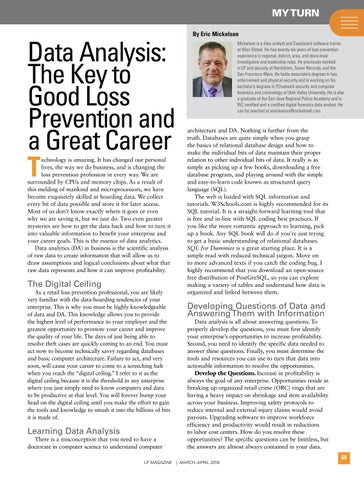My Turn
Data Analysis: The Key to Good Loss Prevention and a Great Career T echnology is amazing. It has changed our personal lives, the way we do business, and is changing the loss prevention profession in every way. We are surrounded by CPUs and memory chips. As a result of this melding of mankind and microprocessors, we have become exquisitely skilled at hoarding data. We collect every bit of data possible and store it for later access. Most of us don’t know exactly where it goes or even why we are saving it, but we just do. Two even greater mysteries are how to get the data back and how to turn it into valuable information to benefit your enterprise and your career goals. This is the essence of data analytics. Data analytics (DA) in business is the scientific analysis of raw data to create information that will allow us to draw assumptions and logical conclusions about what that raw data represents and how it can improve profitability.
The Digital Ceiling
As a retail loss prevention professional, you are likely very familiar with the data-hoarding tendencies of your enterprise. This is why you must be highly knowledgeable of data and DA. This knowledge allows you to provide the highest level of performance to your employer and the greatest opportunity to promote your career and improve the quality of your life. The days of just being able to resolve theft cases are quickly coming to an end. You must act now to become technically savvy regarding databases and basic computer architecture. Failure to act, and very soon, will cause your career to come to a screeching halt when you reach the “digital ceiling.” I refer to it as the digital ceiling because it is the threshold in any enterprise where you just simply need to know computers and data to be productive at that level. You will forever bump your head on the digital ceiling until you make the effort to gain the tools and knowledge to smash it into the billions of bits it is made of.
Learning Data Analysis
There is a misconception that you need to have a doctorate in computer science to understand computer
By Eric Mickelson Mickelson is a data analyst and Caseboard software trainer at 4Sec Global. He has twenty-six years of loss prevention experience in regional, district, area, and store-level investigative and leadership roles. He previously worked in LP and security at Nordstrom, Tower Records, and the San Francisco 49ers. He holds associate’s degrees in law enforcement and physical security and is working on his bachelor’s degrees in IT/network security and computer forensics and criminology at Utah Valley University. He is also a graduate of the San Jose Regional Police Academy and is WZ certified and a certified digital forensics data analyst. He can be reached at emickelson@rocketmail.com.
architecture and DA. Nothing is further from the truth. Databases are quite simple when you grasp the basics of relational database design and how to make the individual bits of data maintain their proper relation to other individual bits of data. It really is as simple as picking up a few books, downloading a free database program, and playing around with the simple and easy-to-learn code known as structured query language (SQL). The web is loaded with SQL information and tutorials. W3Schools.com is highly recommended for its SQL tutorial. It is a straight-forward learning tool that is free and in-line with SQL coding best practices. If you like the more romantic approach to learning, pick up a book. Any SQL book will do if you’re just trying to get a basic understanding of relational databases. SQL for Dummies is a great starting place. It is a simple read with reduced technical jargon. Move on to more advanced texts if you catch the coding bug. I highly recommend that you download an open-source free distribution of PostGreSQL, so you can explore making a variety of tables and understand how data is organized and linked between them.
Developing Questions of Data and Answering Them with Information
Data analysis is all about answering questions. To properly develop the questions, you must first identify your enterprise’s opportunities to increase profitability. Second, you need to identify the specific data needed to answer these questions. Finally, you must determine the tools and resources you can use to turn that data into actionable information to resolve the opportunities. Develop the Questions. Increase in profitability is always the goal of any enterprise. Opportunities reside in breaking up organized retail crime (ORC) rings that are having a heavy impact on shrinkage and item availability across your business. Improving safety protocols to reduce internal and external injury claims would avoid payouts. Upgrading software to improve workforce efficiency and productivity would result in reductions to labor cost centers. How do you resolve these opportunities? The specific questions can be limitless, but the answers are almost always contained in your data.
LP Magazine | march–april 2016
65






